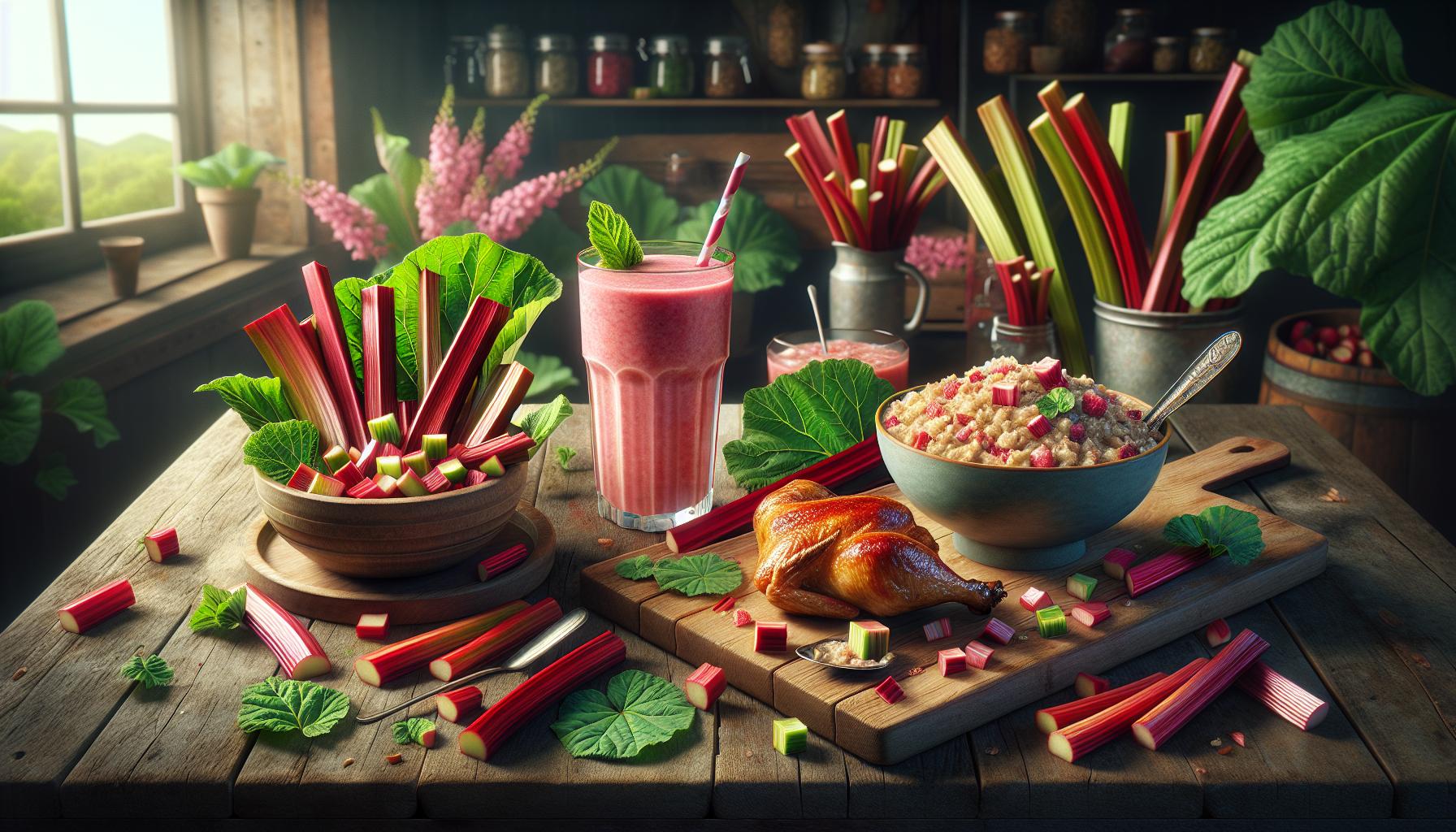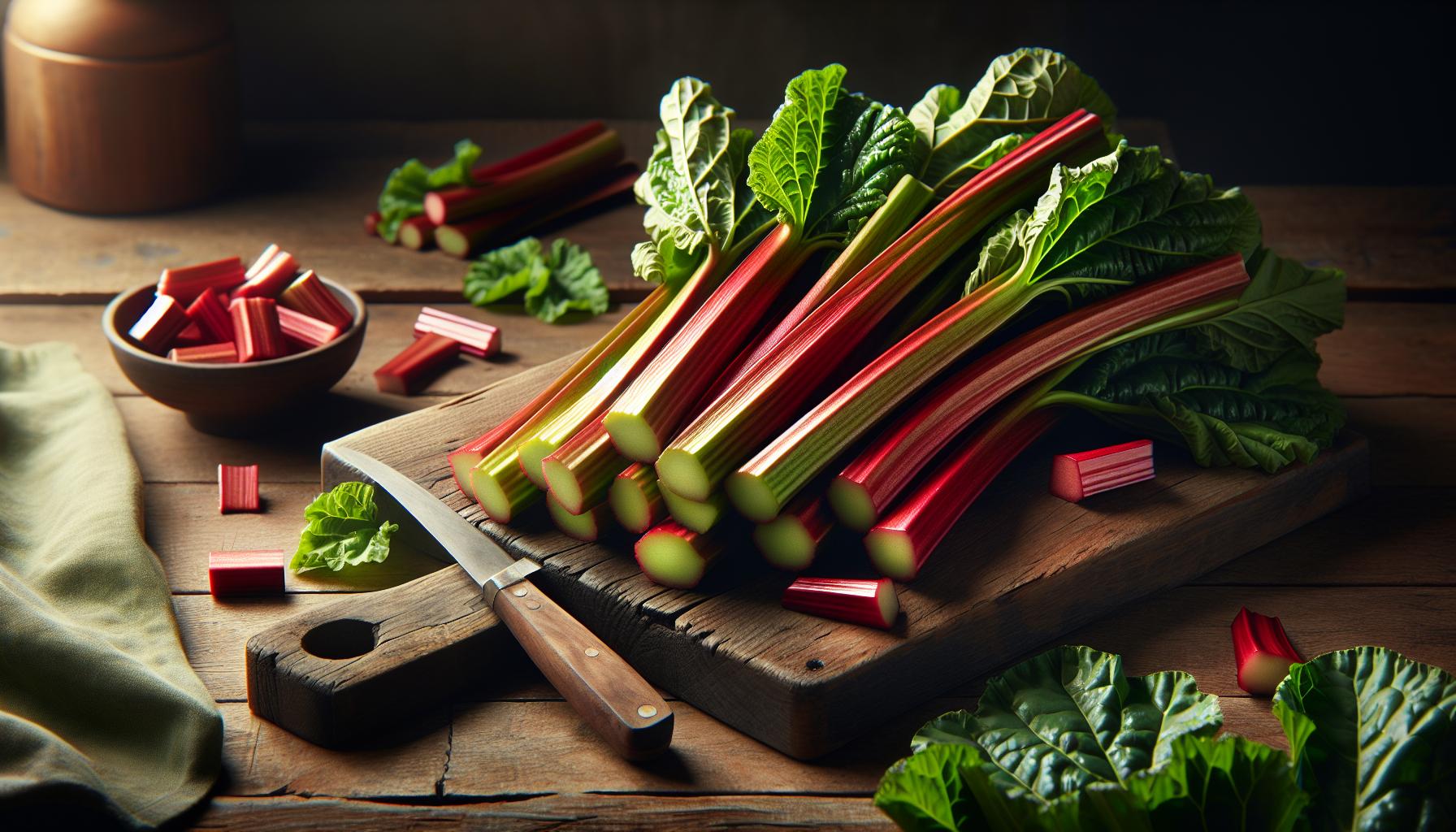Rhubarb is often overlooked in the world of healthy cooking, but it packs a punch when it comes to flavor and nutrition. This vibrant vegetable, with its tart taste and striking red stalks, can elevate your dishes while offering a wealth of health benefits. I’ve discovered that incorporating rhubarb into my meals not only adds a delightful zing but also contributes to a balanced diet.
Key Takeaways
- Nutritional Powerhouse: Rhubarb is low in calories but rich in essential vitamins and minerals such as Vitamin K, Vitamin C, potassium, and fiber, making it a great addition to a healthy diet.
- Health Benefits: Incorporating rhubarb into meals can enhance digestive health, support weight management, boost bone health, and help regulate blood sugar levels due to its antioxidant properties and high fiber content.
- Versatile Ingredient: Rhubarb’s tart flavor can be used in various recipes, from breakfast options like oatmeal and smoothies to main dishes such as glazed chicken and stir-fry, showcasing its culinary versatility.
- Cooking Tips: Select fresh, vibrant stalks for the best flavor, and store rhubarb properly in the refrigerator to extend its freshness. Use cooking techniques like trimming and peeling to enhance tenderness.
- Culinary Traditions: Rhubarb is featured in traditional recipes around the world, such as rhubarb crumble in the UK and pie in the US, illustrating its cultural significance and adaptability in cooking.
- Modern Innovations: Creative uses of rhubarb in modern cooking include savory dishes like salsas, refreshing cocktails, and breakfast toppings, highlighting its unique taste and nutrition in everyday meals.
Rhubarb Healthy Recipes
Rhubarb offers impressive nutritional value and significant health benefits. Incorporating this vibrant vegetable into my diet can optimize well-being.
Nutritional Value
Rhubarb contains low calories, providing only about 21 calories per 100 grams. This makes it a guilt-free addition to meals. Each serving is rich in essential vitamins and minerals, including:
- Vitamin K: Supports bone health and blood clotting.
- Vitamin C: Boosts the immune system and promotes skin health.
- Potassium: Aids in heart health and helps regulate blood pressure.
- Fiber: Promotes digestive health and enhances feelings of fullness.
Health Benefits
The health benefits of rhubarb enhance overall wellness. Key advantages include:
- Antioxidant Properties: Rhubarb is rich in antioxidants, which combat free radicals and reduce oxidative stress.
- Digestive Health: The high fiber content supports regular bowel movements and prevents constipation.
- Weight Management: Low calorie and high fiber make rhubarb a great choice for those looking to manage weight effectively.
- Bone Health: Vitamin K and calcium aid in maintaining strong bones and reducing the risk of fractures.
- Blood Sugar Control: Rhubarb may help stabilize blood sugar levels, making it beneficial for those with diabetes.
Integrating rhubarb into my recipes not only enhances flavor but also boosts nutrition and supports a healthy lifestyle.
Delicious Rhubarb Healthy Recipes

Rhubarb adds a unique tart flavor to various dishes while maintaining its nutritional value. Here are some healthy recipe ideas that incorporate this vibrant vegetable.
Breakfast Ideas
- Rhubarb Oatmeal: Combine rolled oats, diced rhubarb, and almond milk. Cook until creamy and top with almonds and honey for sweetness.
- Rhubarb Smoothie: Blend fresh rhubarb with banana, spinach, and Greek yogurt. Add a splash of orange juice for extra flavor.
- Rhubarb Chia Pudding: Mix chia seeds with almond milk and a touch of maple syrup. Stir in cooked rhubarb and refrigerate overnight for a nutritious breakfast.
Main Course Dishes
- Rhubarb Glazed Chicken: Marinate chicken breasts in a sauce made from rhubarb, honey, and mustard. Bake until golden for a tangy twist on a classic dish.
- Rhubarb Stir-Fry: Sauté rhubarb with broccoli, bell peppers, and tofu. Add soy sauce and sesame oil for a healthy and colorful meal.
- Rhubarb Quinoa Salad: Toss cooked quinoa with roasted rhubarb, arugula, and walnuts. Drizzle with balsamic vinaigrette for added flavor.
- Rhubarb Yogurt Parfait: Layer Greek yogurt with rhubarb compote and granola for a satisfying snack.
- Rhubarb Energy Bites: Combine oats, nut butter, chopped rhubarb, and dark chocolate chips. Form into bites for a quick energy boost.
- Rhubarb Crisp: Bake rhubarb with a topping of oats, almond flour, and cinnamon. Serve warm with a dollop of yogurt for a healthy dessert option.
Tips For Cooking With Rhubarb

Cooking with rhubarb enhances dishes and highlights its unique flavor. Following these tips ensures the best results while enjoying this nutritious vegetable.
Choosing Fresh Rhubarb
Selecting fresh rhubarb is crucial for optimal flavor and quality. Look for vibrant, firm stalks without blemishes or soft spots. Choose stalks at least 12 inches long for increased tenderness. Avoid rhubarb with a yellowish hue, as it indicates over-maturity. Harvesting rhubarb in the spring yields the best taste, so always check local farmers’ markets during this season for peak freshness.
Storage and Preparation Techniques
Proper storage preserves rhubarb’s freshness and flavor. Store unwashed rhubarb in the refrigerator, wrapped in a damp paper towel within a plastic bag, for up to one week. When preparing rhubarb, wash the stalks under cold water, then trim the ends and peel the outer layer for more tenderness. Cut stalks into uniform pieces for even cooking. By incorporating these techniques, I ensure rhubarb retains its vibrant color and tart taste in any dish.
Rhubarb In Various Cuisines

Rhubarb features prominently across various cuisines, showcasing its versatility. Its tart flavor complements both sweet and savory dishes, enriching global culinary traditions.
Traditional Recipes
Traditional recipes often highlight rhubarb’s tangy profile. In the UK, I enjoy rhubarb crumble, where the stalks are stewed with sugar before being topped with a buttery crumble. This dessert balances tartness and sweetness beautifully. In the U.S., rhubarb pie stands out, typically combining fresh rhubarb with sugar and a flaky crust. The distinct tartness offers a refreshing contrast to the sweetness, making it a favorite during spring. Additionally, in Scandinavia, rhubarb soup serves as a traditional treat, typically sweetened with sugar and served chilled, perfect for hot summer days.
Modern Twists
Modern recipes adapt rhubarb in innovative ways. I often use rhubarb in savory dishes, such as rhubarb salsa, which combines diced rhubarb with tomatoes, cilantro, and lime, creating a zesty topping for grilled fish or chicken. Rhubarb compote also adds a fresh twist to breakfast foods; spooned over Greek yogurt or pancakes, it adds a punchy flavor while maintaining nutritional benefits. Furthermore, I love incorporating rhubarb in cocktails, mixing it with gin or vodka for a refreshing drink. These modern uses not only celebrate rhubarb’s unique taste but also enhance its appeal in everyday meals.
Impressive Benefits
Rhubarb’s unique flavor and impressive health benefits make it a fantastic addition to my kitchen. I love how it can transform both sweet and savory dishes while keeping meals nutritious. Whether I’m whipping up a rhubarb crisp or adding it to a savory stir-fry, it never fails to impress.
As I experiment with different recipes, I find that rhubarb not only enhances the taste but also supports my health goals. I encourage you to explore this versatile vegetable and incorporate it into your meals. With its vibrant color and tangy profile, rhubarb is sure to brighten up any dish while contributing to a balanced diet.



